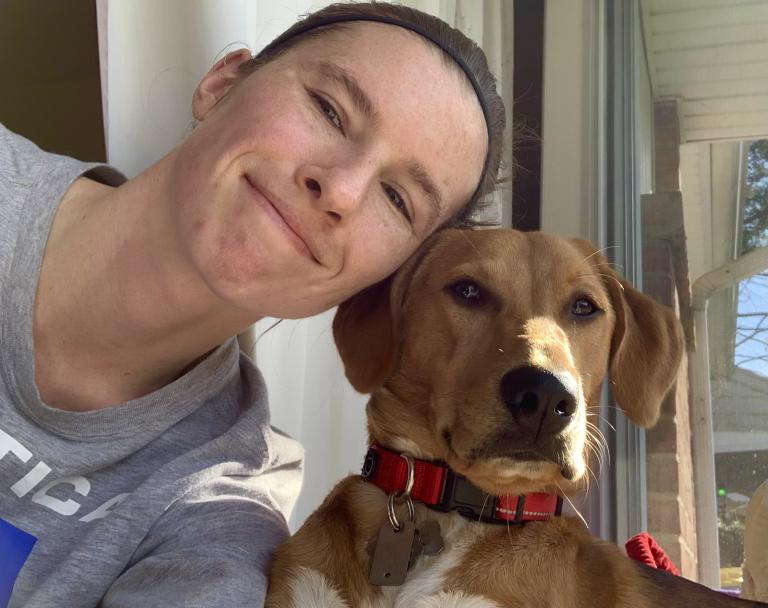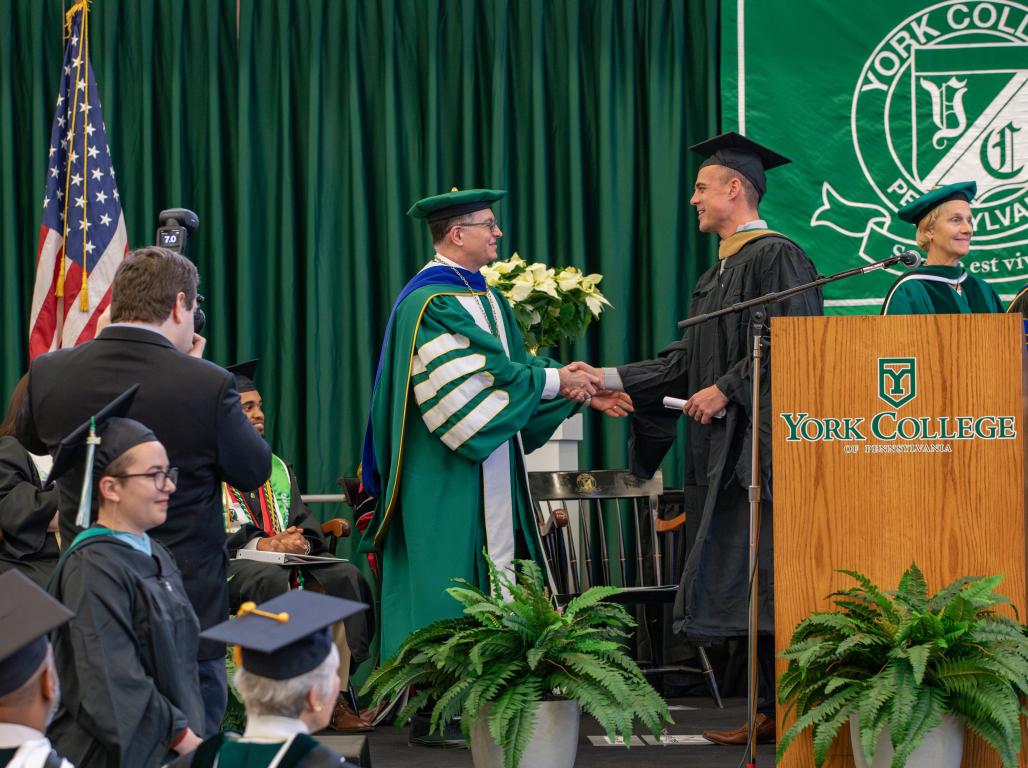Jennifer Hindley has spent much of her adult life wrestling with serious illness. She uses her pain to encourage and educate others going through similar circumstances.
York College of Pennsylvania alumna Jen Hindley ’17 knows pain, and she wants it to serve a purpose. Since 2010, struggle after struggle has left her wheelchair-bound with one leg. She hurts continuously. Still, Hindley refuses to let the pain define her.
The Long Island, New York, native came to York College in 2009 on a Valedictorian Scholarship as a Biology and Secondary Education major. Then, a rugby accident in 2010 led to a traumatic brain injury. That health setback and side effects, including seizures, a slipped disc, and partial leg paralysis, forced Hindley to step back from her studies.
“I tried to hide it, to convince everyone that I would be okay,” Hindley says. “But when I tried to go back in the fall, I couldn’t even remember how to get from class to my dorm.”
An undying dream
Hindley’s dream was to return to York College. After extensive therapy, she was ready to put the injury behind her. The College had offered to hold her scholarship for her. In 2014, her parents divorced and her mom, who is now her full-time caregiver, asked where she wanted to go.
Hindley was ready to return to York College.
In the fall of that year, Hindley and her mom moved to Springettsbury Township, and in January 2015, she returned to York College. During her time away, she had discovered her true passion: writing. Hindley re-enrolled as a Professional Writing major with a Speech Communications minor. She graduated in 2017 with a 4.0 grade point average.
During her first semester back, Hindley met Gail Huganir, Director of Editorial Services for the College. Huganir mentioned that if Hindley wanted to serve an internship with her, she should reach out. During her final two semesters, Hindley accepted the offer and wrote numerous articles for the College magazine and website.
“I absolutely loved it so much,” she recalls.
A new setback
Before she graduated, a York newspaper offered Hindley a job. Because of her seizures, however, she couldn't drive, and working as a reporter wasn't feasible. Then, in January 2018, Hindley shattered her left heel.
A botched surgery followed by an attempt to fix the issue left Hindley with a foot and leg that began to turn black. Then horrible bouts of pain with seemingly no explanation began taking over her life. Nearly two years and another surgery later, Hindley was in so much pain that she couldn’t move without screaming.
Seeking out doctor after doctor to find the cause, Hindley finally was diagnosed nearly two years and two major surgeries later with complex regional pain syndrome, or CRPS, also known as “the suicide disease” because the pain is unbearable. Shortly after her diagnosis, Hindley nearly lost her life to a near whole-body spread of the condition. Following a 10-day stay at Hershey Medical Center and three weeks at an inpatient rehab, she was sent home unable to care for herself at all.
A Spinal Cord Stimulator and Dorsal Root Ganglion Stimulator were implanted in her epidural space (an area of spinal anatomy that is located between the vertebral canal and the spinal cord) and provided decent relief to her back and right leg. Additionally, a Peripheral Nerve Stimulator was implanted and removed from her left leg in a week because it only made her pain worse. CRPS became destructive 15 months after the implants.
“It feels like you’re being burned alive,” Hindley says.
The disease is the most painful condition ever recorded, according to the McGill Pain Scale. Doctors attempted embedding a Peripheral Nerve Stimulator and a Dorsal Root Ganglion Stimulator onto her spine, with limited success.
By December 2021, the disease became destructive to her left leg. On March 18, 2022, doctors amputated the leg below the knee. The issues continued, in March 2023, another surgery revised the original amputation, as her tibia had broken through the muscle at the bottom of the residual limb and was trying to break through the skin. Under the care of a new surgeon, she was able to keep her knee.
Finding hope in pain
Though Hindley’s journey had been difficult and marked by severe pain, she realized that if she was going to survive, she needed her pain to have a purpose.
“Pain dictates a lot of what I can and cannot do,” Hindley says, “but I don’t want to be known for the person who hurt a lot, the person who suffered and lost a leg. I want to be known as someone who went through a lot but uses whatever energy they have to help those they can.”
She began documenting her journey on her YouTube channel, The Will to Walk, creating a 17-episode series on spinal cord stimulator basics. Through that channel, she has helped people with CRPS receive a diagnosis and get relief long before they would have otherwise. She also is an administrator on a Spinal Cord Stimulators group that focuses on sharing, supporting, and educating its nearly 1,000 members, as well as on other chronic pain groups.
On her YouTube channel, Hindley discusses her amputations and living with chronic pain, offering free materials such as questions to print out and bring to doctor appointments and links to hard-to-find medical device information. She has presented lectures to University of Wisconsin-Madison students about CRPS.
“I try to be a source of hope,” she says.
After reading the comments of chronic pain sufferers on her Facebook groups, she likes to send blankets and notes of encouragement to them. Often, she’ll find gifts of quilts or flowers and notes in her mailbox from others who do the same.
When Hindley began documenting her journey, she hoped it would be a story of relief and recovery. Instead, she has walked her viewers through raw frustrations, failures, infections, and setbacks. Still, she keeps going, her trusty pup, Krieger, which means warrior in German, at her side.
“You can survive a lot more than you think you can,” she says, “and you can make something out of it, too, not just surviving, but giving it meaning. You can make it through and you can make a difference.”





